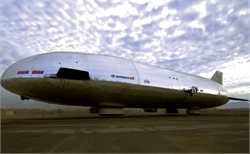| Dragon Dream | |
|---|---|
 Dragon Dream experimental cargo air ship | |
| General information | |
| Type | ML866 [1] |
| National origin | United States |
| Manufacturer | Worldwide Aeros Corp |
| Designer | Igor Pasternak |
| Construction number | 0023 [1] |
| Registration | N866ML [1] |
Dragon Dream (FAA registration: N866ML [1] ) is an experimental [1] lighter than air (LTA) cargo rigid airship built by Worldwide Aeros Corp as a half-scale proof of concept prototype for a design which the manufacturer calls the "Aeroscraft". [2] The development and design has been funded by the US government through the military Walrus HULA and then the "Pelican" projects. [3]